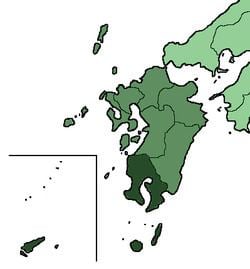200,000 30,000 Result Toyotomi victory | Period 1586 – 1587 Location Kyushu, Japan | |
 | ||
Similar Siege of Odawara, Battle of Shizugatake, Battle of Komaki and Naga, Battle of Yamazaki, Battle of Hetsugigawa | ||
Ky sh campaign
The Kyūshū Campaign of 1586–1587 was part of the campaigns of Toyotomi Hideyoshi who sought to dominate Japan at the end of the Sengoku period. Having subjugated much of Honshū and Shikoku, Hideyoshi turned his attention to the southernmost of the main Japanese islands, Kyūshū, in 1587.
Contents
Course of events
Battles had raged for the previous few years between the daimyo of Kyūshū, and by 1587 the Shimazu family of Satsuma were the primary power on the island. In 1586, they heard of Hideyoshi's plans for invasion, and lifted their siege of Tachibana castle, withdrawing a great portion of their forces back to Higo province, while the rest stayed in Bungo province. There, they seized Funai Castle from the Ōtomo clan and prepared for the invasion.
The Ōtomo were supported by armies under Sengoku Hidehisa and Chōsokabe Motochika, a major Shikoku lord who had been defeated by Hideyoshi the previous year, and had thus joined him. Though Bungo province ultimately fell to the Shimazu. Sengoku and Chōsokabe delayed them, however, and weakened them in preparation for the arrival of Hideyoshi's armies and those of the Mōri clan, another ally of Hideyoshi.
Hashiba Hidenaga, half-brother to Hideyoshi, landed to the south of Bungo, attacking the Shimazu at Takajō, on Kyūshū's eastern coast, in 1587. Meanwhile, Hideyoshi took his own forces down a more westerly route, attacking Ganjaku Castle in Chikuzen province, which was held by the Akizuki clan. Later that year, the two brothers would meet up in the Shimazu's home province of Satsuma, to assault their home castle at Kagoshima. Ultimately, Kagoshima itself was not attacked; the Shimazu surrendered, leaving Hideyoshi to return his attention to the Hōjō clan of the Kantō, the last major clan to oppose him.
Hideyoshi would make use of Kyūshū through much of the 1590s in his attacks on Korea.
